YAMAHA PW50 2016 Repair Manual
Manufacturer: YAMAHA, Model Year: 2016, Model line: PW50, Model: YAMAHA PW50 2016Pages: 80, PDF Size: 1.84 MB
Page 61 of 80
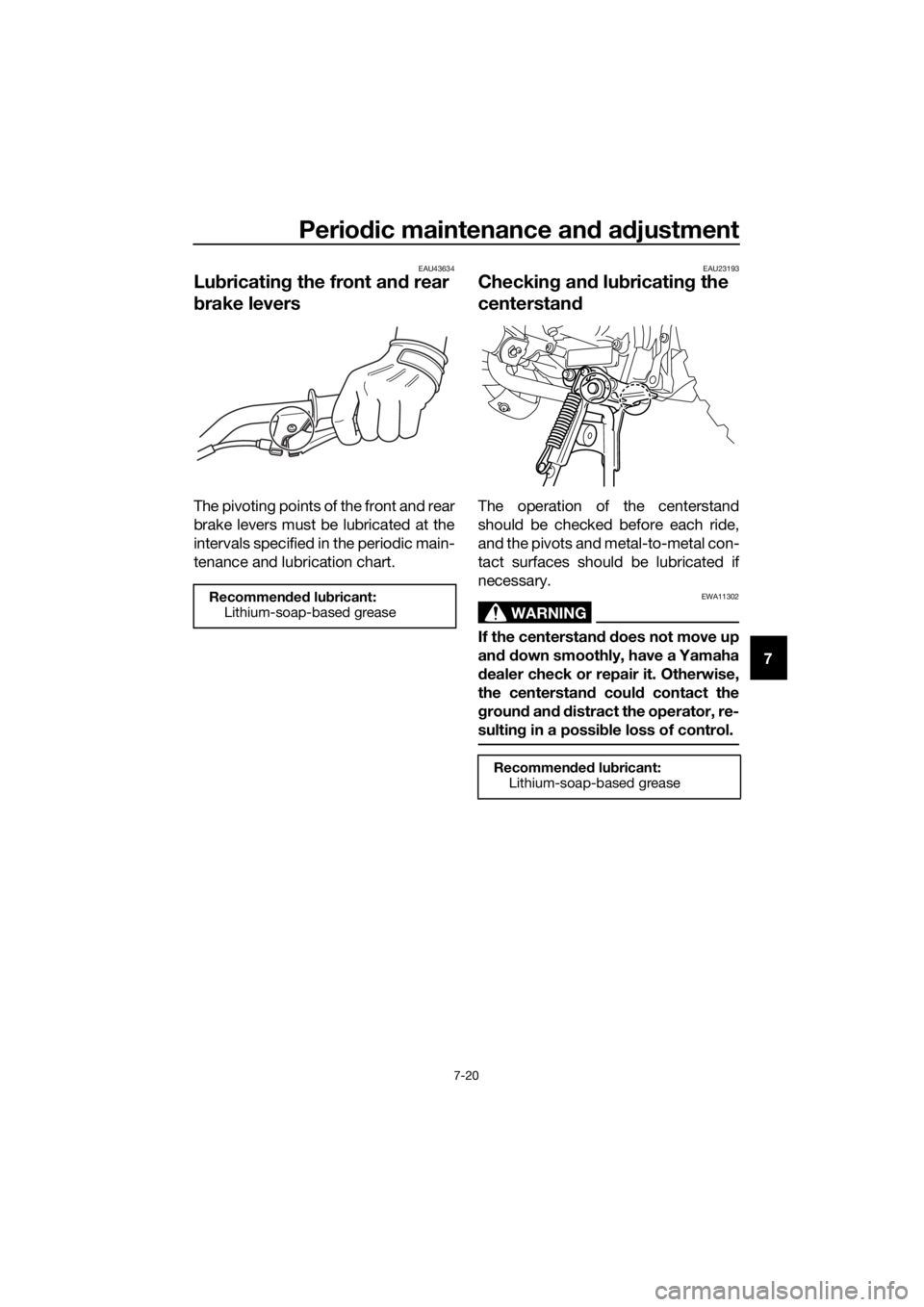
Periodic maintenance an d a djustment
7-20
7
EAU43634
Lub ricatin g the front an d rear
b rake levers
The pivoting points of the front and rear
brake levers must be lubricated at the
intervals specified in the periodic main-
tenance and lubrication chart.
EAU23193
Checkin g an d lu bricatin g the
centerstan d
The operation of the centerstand
should be checked before each ride,
and the pivots and metal-to-metal con-
tact surfaces should be lubricated if
necessary.
WARNING
EWA11302
If the centerstan d d oes not move up
an d d own smoothly, have a Yamaha
d ealer check or repair it. Otherwise,
the centerstan d coul d contact the
g roun d an d d istract the operator, re-
sultin g in a possib le loss of control.
Recommen ded lu bricant:
Lithium-soap-based grease
Recommen ded lu bricant:
Lithium-soap-based grease
U2SA82E0.book Page 20 Monday, June 8, 2015 1:09 PM
Page 62 of 80

Periodic maintenance an d a djustment
7-21
7
EAU42082
Checkin g the front fork
The condition and operation of the
front fork must be checked as follows
at the intervals specified in the periodic
maintenance and lubrication chart.
To check the con dition
Check the inner tubes for scratches
and damage.
To check the operation 1. Place the vehicle on a level surfa- ce and hold it in an upright posi-
tion. WARNING! To avoi d injury,
securely support the vehicle so
there is no dan ger of it fallin g
over.
[EWA10752]
2. While applying the front brake, push down hard on the handle-
bars several times to check if the
front fork compresses and re-
bounds smoothly.
NOTICE
ECA10591
If any d amage is foun d or the front
fork does not operate smoothly,
have a Yamaha dealer check or re-
pair it.
EAU45512
Checkin g the steerin g
Worn or loose steering bearings may
cause danger. Therefore, the operation
of the steering must be checked as fol-
lows at the intervals specified in the
periodic maintenance and lubrication
chart.
1. Place the vehicle on the center- stand. WARNING! To avoi d inju-
ry, securely support the vehicle
so there is no dan ger of it fallin g
over.
[EWA10752]
2. Hold the lower ends of the front fork legs and try to move them for-
ward and backward. If any free
play can be felt, have a Yamaha
dealer check or repair the steer-
ing.
U2SA82E0.book Page 21 Monday, June 8, 2015 1:09 PM
Page 63 of 80
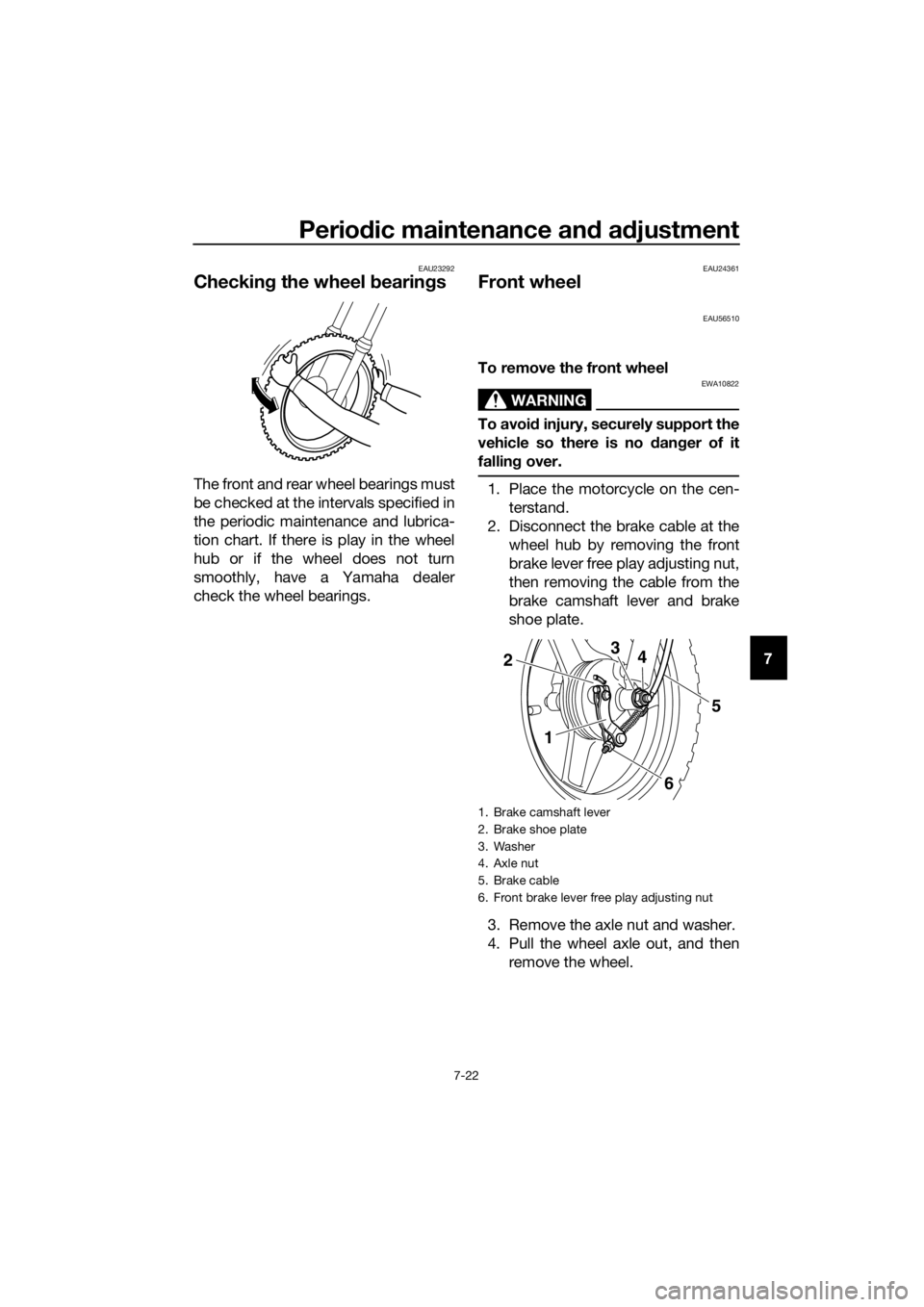
Periodic maintenance an d a djustment
7-22
7
EAU23292
Checkin g the wheel b earings
The front and rear wheel bearings must
be checked at the intervals specified in
the periodic maintenance and lubrica-
tion chart. If there is play in the wheel
hub or if the wheel does not turn
smoothly, have a Yamaha dealer
check the wheel bearings.
EAU24361
Front wheel
EAU56510
To remove the front wheel
WARNING
EWA10822
To avoi d injury, securely support the
vehicle so there is no dan ger of it
fallin g over.
1. Place the motorcycle on the cen-
terstand.
2. Disconnect the brake cable at the wheel hub by removing the front
brake lever free play adjusting nut,
then removing the cable from the
brake camshaft lever and brake
shoe plate.
3. Remove the axle nut and washer.
4. Pull the wheel axle out, and then remove the wheel.
1. Brake camshaft lever
2. Brake shoe plate
3. Washer
4. Axle nut
5. Brake cable
6. Front brake lever free play adjusting nut
5
6
1 3
4
2
U2SA82E0.book Page 22 Monday, June 8, 2015 1:09 PM
Page 64 of 80
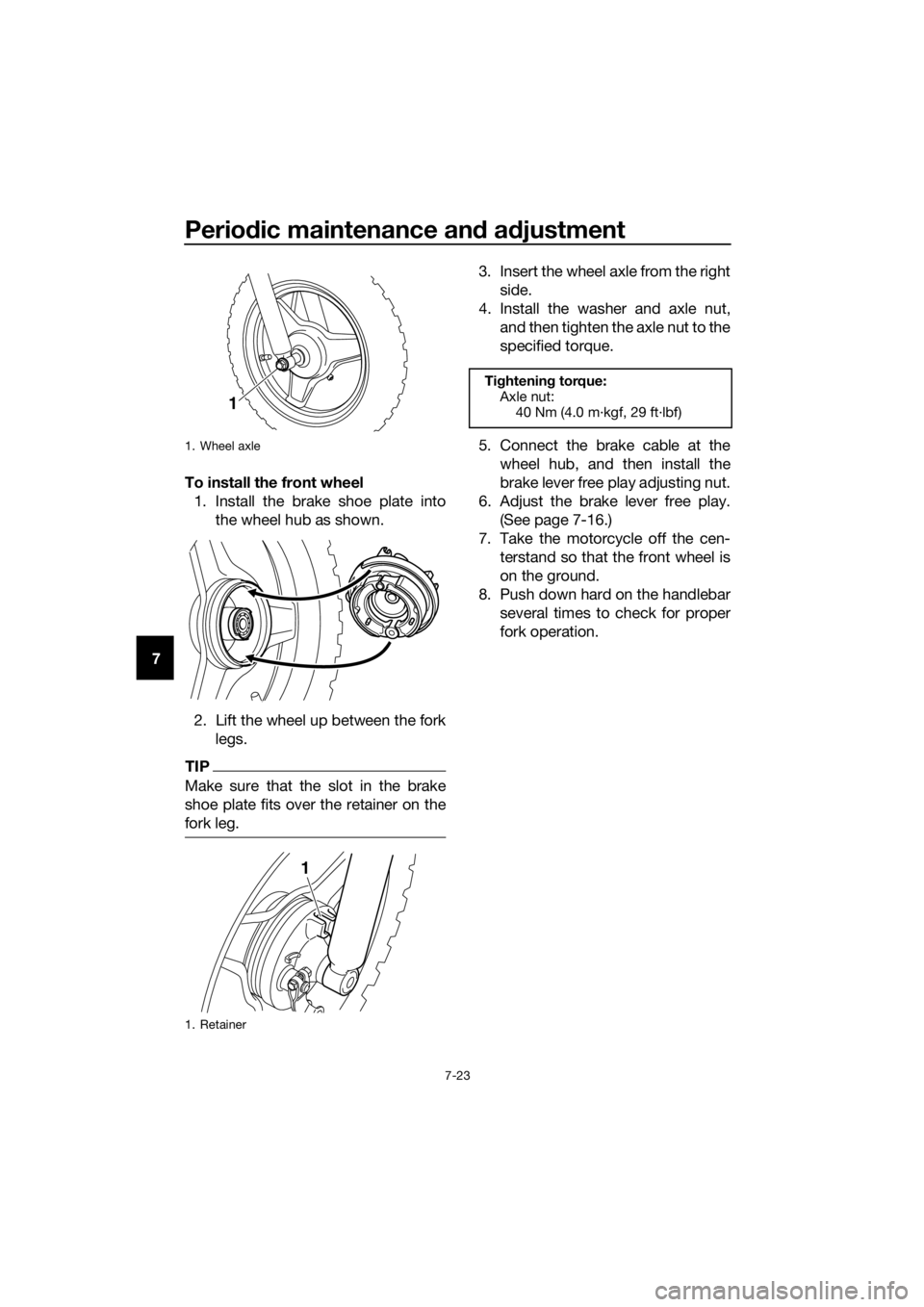
Periodic maintenance an d a djustment
7-23
7 To install the front wheel
1. Install the brake shoe plate into the wheel hub as shown.
2. Lift the wheel up between the fork legs.
TIP
Make sure that the slot in the brake
shoe plate fits over the retainer on the
fork leg.
3. Insert the wheel axle from the rightside.
4. Install the washer and axle nut, and then tighten the axle nut to the
specified torque.
5. Connect the brake cable at the wheel hub, and then install the
brake lever free play adjusting nut.
6. Adjust the brake lever free play. (See page 7-16.)
7. Take the motorcycle off the cen- terstand so that the front wheel is
on the ground.
8. Push down hard on the handlebar several times to check for proper
fork operation.
1. Wheel axle
1. Retainer
1
1
Tightening torque:
Axle nut: 40 Nm (4.0 m·kgf, 29 ft·lbf)
U2SA82E0.book Page 23 Monday, June 8, 2015 1:09 PM
Page 65 of 80
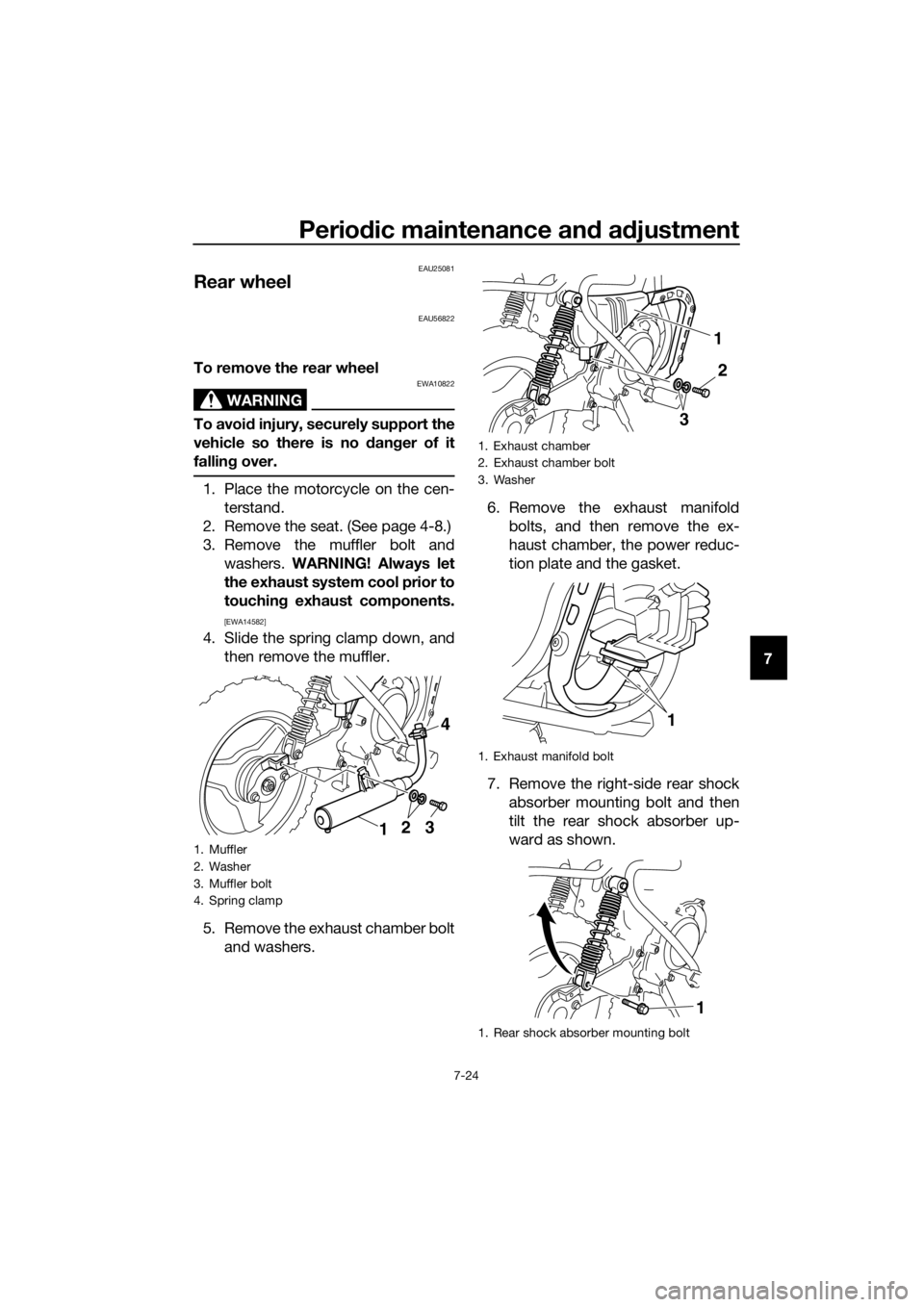
Periodic maintenance an d a djustment
7-24
7
EAU25081
Rear wheel
EAU56822
To remove the rear wheel
WARNING
EWA10822
To avoi d injury, securely support the
vehicle so there is no d anger of it
fallin g over.
1. Place the motorcycle on the cen-
terstand.
2. Remove the seat. (See page 4-8.)
3. Remove the muffler bolt and washers. WARNING! Always let
the exhaust system cool prior to
touchin g exhaust components.
[EWA14582]
4. Slide the spring clamp down, and
then remove the muffler.
5. Remove the exhaust chamber bolt and washers. 6. Remove the exhaust manifold
bolts, and then remove the ex-
haust chamber, the power reduc-
tion plate and the gasket.
7. Remove the right-side rear shock absorber mounting bolt and then
tilt the rear shock absorber up-
ward as shown.
1. Muffler
2. Washer
3. Muffler bolt
4. Spring clamp
312 4
1. Exhaust chamber
2. Exhaust chamber bolt
3. Washer
1. Exhaust manifold bolt
1. Rear shock absorber mounting bolt
2
1
3
1
1
U2SA82E0.book Page 24 Monday, June 8, 2015 1:09 PM
Page 66 of 80
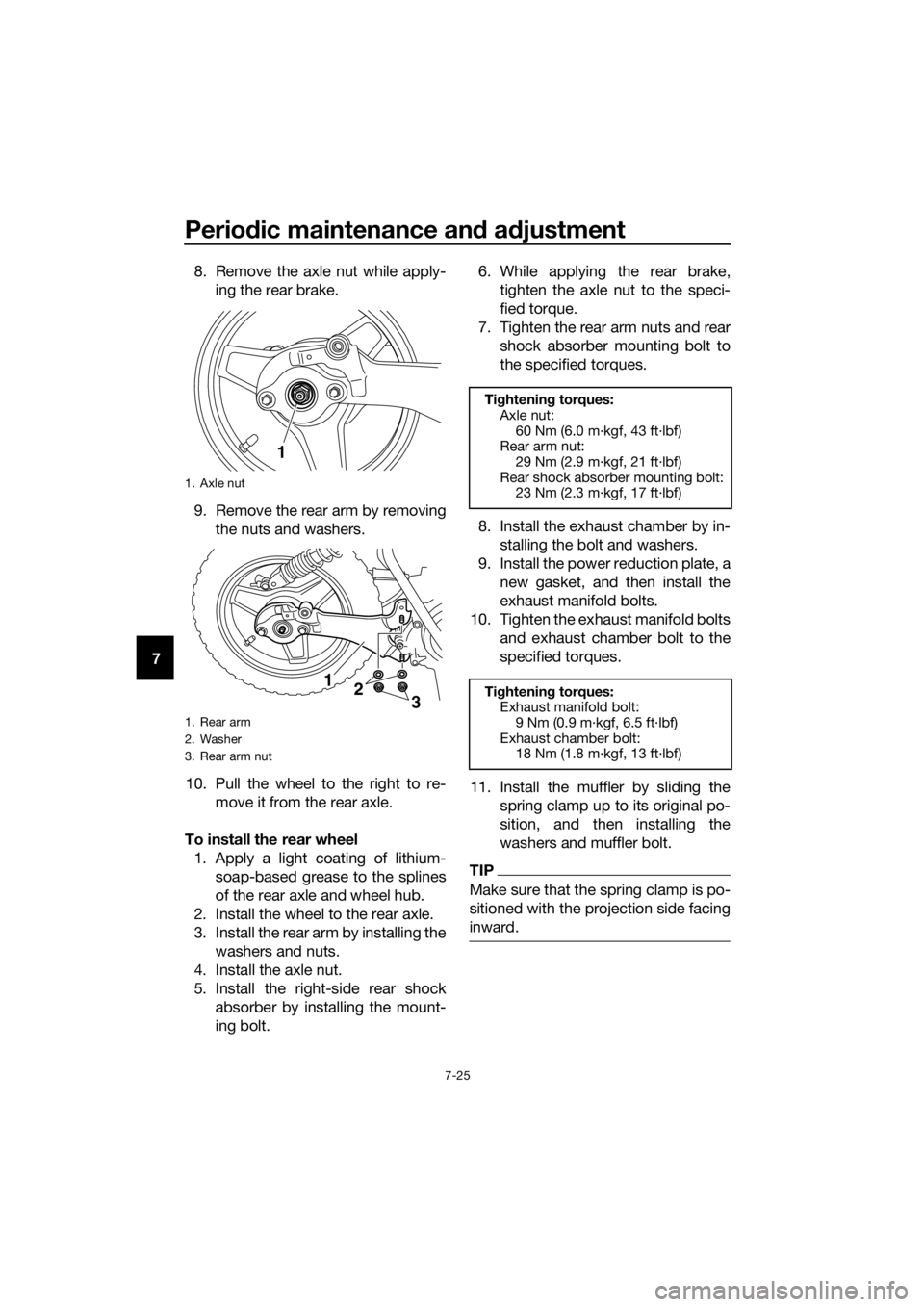
Periodic maintenance an d a djustment
7-25
7 8. Remove the axle nut while apply-
ing the rear brake.
9. Remove the rear arm by removing the nuts and washers.
10. Pull the wheel to the right to re- move it from the rear axle.
To install the rear wheel 1. Apply a light coating of lithium- soap-based grease to the splines
of the rear axle and wheel hub.
2. Install the wheel to the rear axle.
3. Install the rear arm by installing the washers and nuts.
4. Install the axle nut.
5. Install the right-side rear shock absorber by installing the mount-
ing bolt. 6. While applying the rear brake,
tighten the axle nut to the speci-
fied torque.
7. Tighten the rear arm nuts and rear shock absorber mounting bolt to
the specified torques.
8. Install the exhaust chamber by in- stalling the bolt and washers.
9. Install the power reduction plate, a new gasket, and then install the
exhaust manifold bolts.
10. Tighten the exhaust manifold bolts and exhaust chamber bolt to the
specified torques.
11. Install the muffler by sliding the spring clamp up to its original po-
sition, and then installing the
washers and muffler bolt.
TIP
Make sure that the spring clamp is po-
sitioned with the projection side facing
inward.
1. Axle nut
1. Rear arm
2. Washer
3. Rear arm nut
1
12
3
Tightening torques:
Axle nut: 60 Nm (6.0 m·kgf, 43 ft·lbf)
Rear arm nut:
29 Nm (2.9 m·kgf, 21 ft·lbf)
Rear shock absorber mounting bolt: 23 Nm (2.3 m·kgf, 17 ft·lbf)
Ti ghtening torques:
Exhaust manifold bolt:
9 Nm (0.9 m·kgf, 6.5 ft·lbf)
Exhaust chamber bolt: 18 Nm (1.8 m·kgf, 13 ft·lbf)
U2SA82E0.book Page 25 Monday, June 8, 2015 1:09 PM
Page 67 of 80
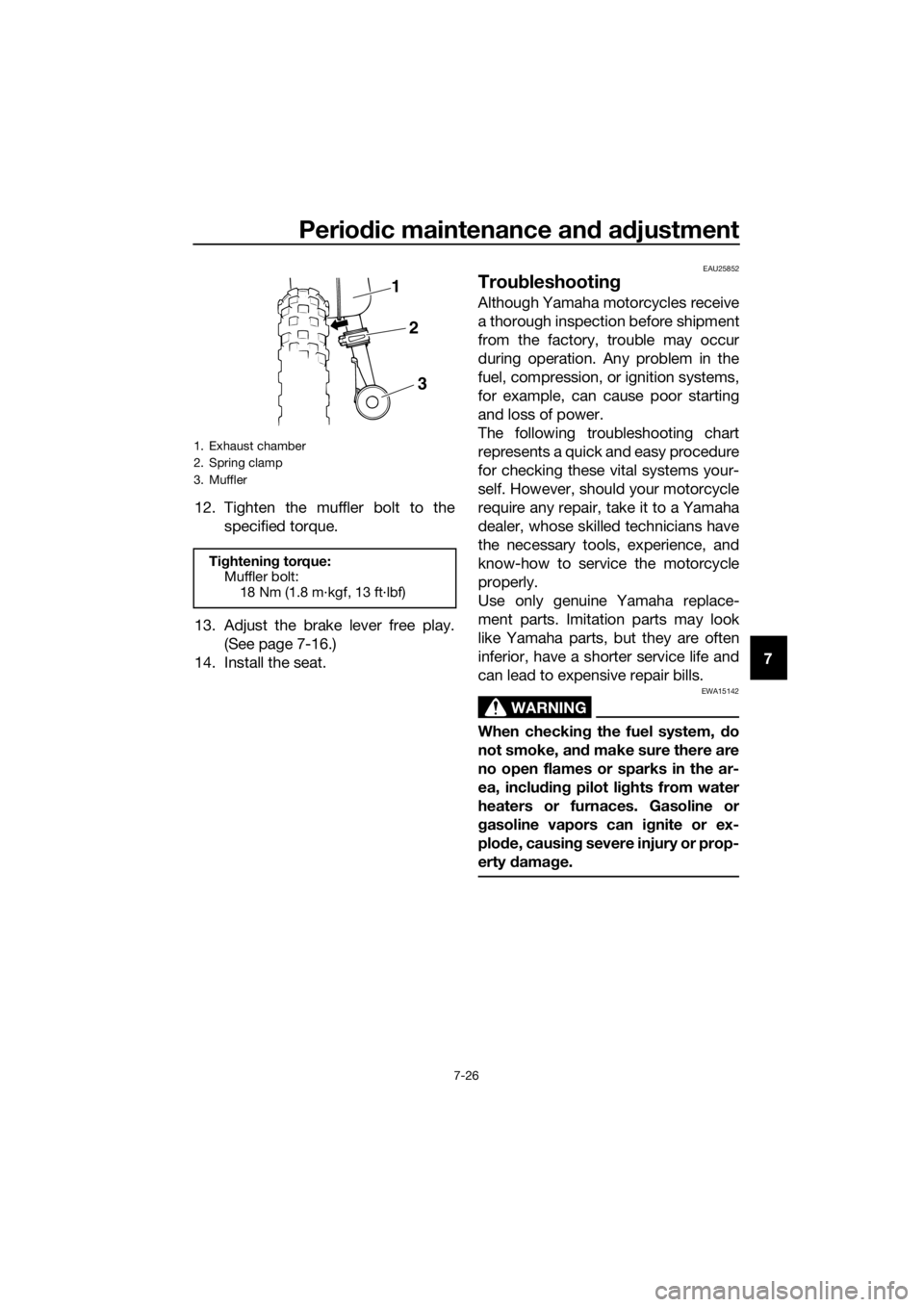
Periodic maintenance an d a djustment
7-26
7
12. Tighten the muffler bolt to the
specified torque.
13. Adjust the brake lever free play. (See page 7-16.)
14. Install the seat.
EAU25852
Trou bleshootin g
Although Yamaha motorcycles receive
a thorough inspection before shipment
from the factory, trouble may occur
during operation. Any problem in the
fuel, compression, or ignition systems,
for example, can cause poor starting
and loss of power.
The following troubleshooting chart
represents a quick and easy procedure
for checking these vital systems your-
self. However, should your motorcycle
require any repair, take it to a Yamaha
dealer, whose skilled technicians have
the necessary tools, experience, and
know-how to service the motorcycle
properly.
Use only genuine Yamaha replace-
ment parts. Imitation parts may look
like Yamaha parts, but they are often
inferior, have a shorter service life and
can lead to expensive repair bills.
WARNING
EWA15142
When checkin g the fuel system, do
not smoke, an d make sure there are
no open flames or sparks in the ar-
ea, inclu din g pilot li ghts from water
heaters or furnaces. Gasoline or
g asoline vapors can i gnite or ex-
plo de, causin g severe injury or prop-
erty damag e.
1. Exhaust chamber
2. Spring clamp
3. Muffler
Tightening torque:
Muffler bolt:
18 Nm (1.8 m·kgf, 13 ft·lbf)
1
2
3
U2SA82E0.book Page 26 Monday, June 8, 2015 1:09 PM
Page 68 of 80
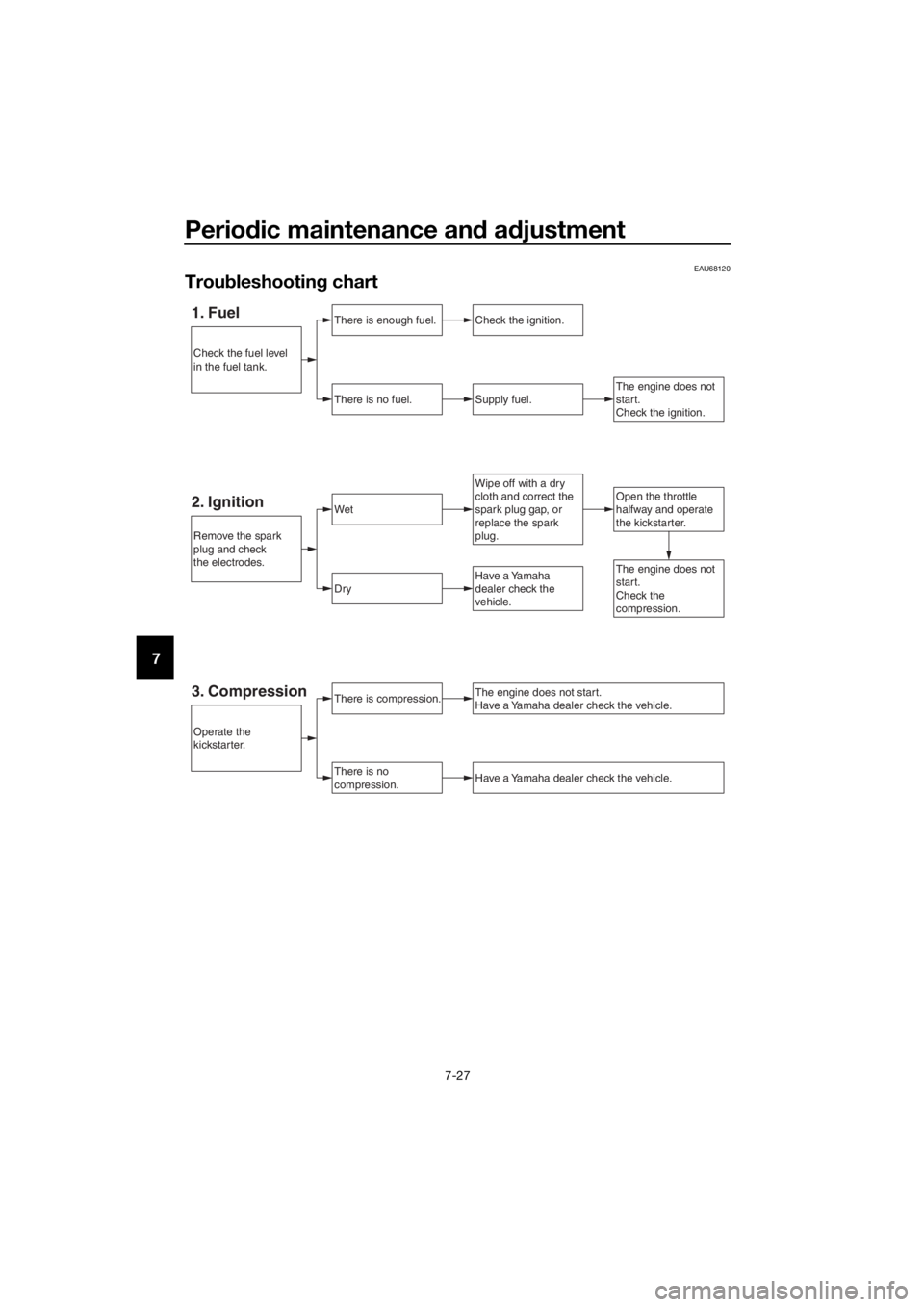
Periodic maintenance an d a djustment
7-27
7
EAU68120
Trou bleshootin g chart
1. FuelThere is enough fuel.
There is no fuel.
Check the ignition.
Supply fuel.The engine does not
start.
Check the ignition.
Open the throttle
halfway and operate
the kickstarter.Wipe off with a dry
cloth and correct the
spark plug gap, or
replace the spark
plug.
2. IgnitionWet
Dry
There is compression.
There is no
compression.
The engine does not start.
Have a Yamaha dealer check the vehicle.
Have a Yamaha dealer check the vehicle.
The engine does not
start.
Check the
compression.Have a Yamaha
dealer check the
vehicle.
Remove the spark
plug and check
the electrodes.
Operate the
kickstarter.
Check the fuel level
in the fuel tank.
3. Compression
U2SA82E0.book Page 27 Monday, June 8, 2015 1:09 PM
Page 69 of 80
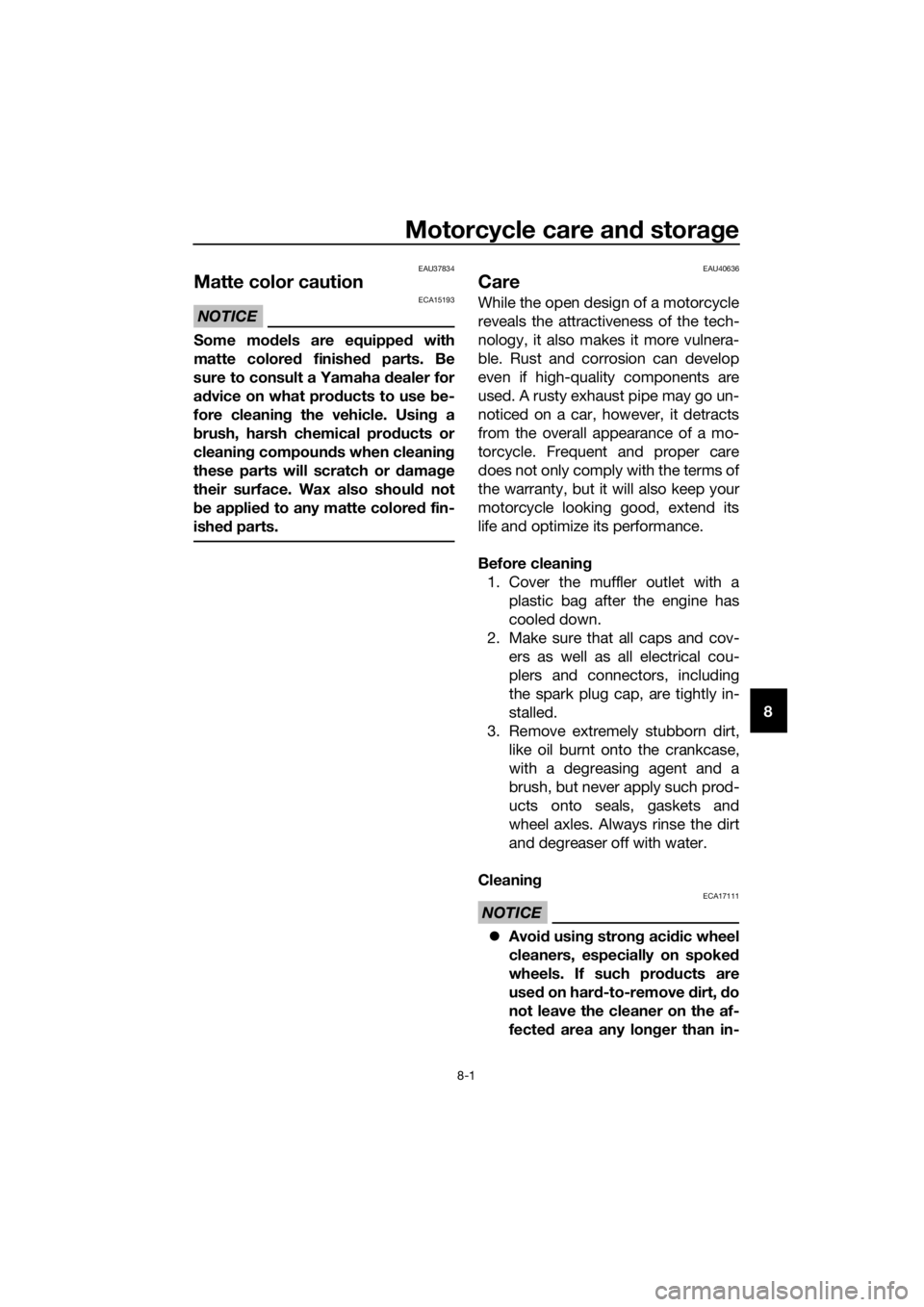
Motorcycle care and stora ge
8-1
8
EAU37834
Matte color caution
NOTICE
ECA15193
Some mo dels are equipped with
matte colored finished parts. Be
sure to consult a Yamaha dealer for
a d vice on what pro ducts to use be-
fore cleanin g the vehicle. Usin g a
b rush, harsh chemical prod ucts or
cleanin g compoun ds when cleanin g
these parts will scratch or damag e
their surface. Wax also shoul d not
b e applie d to any matte colored fin-
ishe d parts.
EAU40636
Care
While the open design of a motorcycle
reveals the attractiveness of the tech-
nology, it also makes it more vulnera-
ble. Rust and corrosion can develop
even if high-quality components are
used. A rusty exhaust pipe may go un-
noticed on a car, however, it detracts
from the overall appearance of a mo-
torcycle. Frequent and proper care
does not only comply with the terms of
the warranty, but it will also keep your
motorcycle looking good, extend its
life and optimize its performance.
Before cleanin g
1. Cover the muffler outlet with a plastic bag after the engine has
cooled down.
2. Make sure that all caps and cov- ers as well as all electrical cou-
plers and connectors, including
the spark plug cap, are tightly in-
stalled.
3. Remove extremely stubborn dirt, like oil burnt onto the crankcase,
with a degreasing agent and a
brush, but never apply such prod-
ucts onto seals, gaskets and
wheel axles. Always rinse the dirt
and degreaser off with water.
Cleanin g
NOTICE
ECA17111
Avoi d using strong aci dic wheel
cleaners, especially on spoked
wheels. If such pro ducts are
use d on har d-to-remove dirt, do
not leave the cleaner on the af-
fected area any lon ger than in-
U2SA82E0.book Page 1 Monday, June 8, 2015 1:09 PM
Page 70 of 80
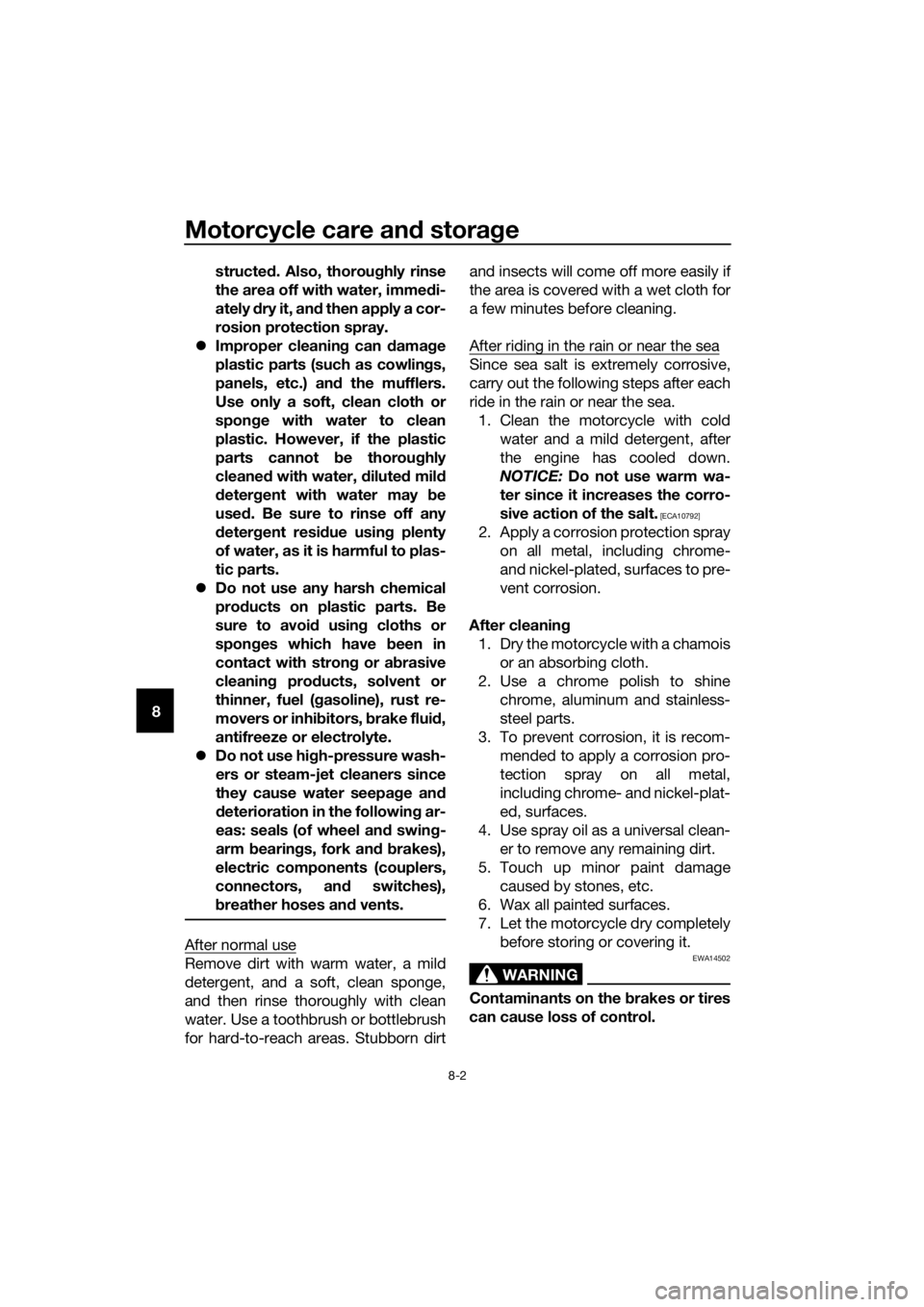
Motorcycle care and stora ge
8-2
8 structe
d. Also, thorou ghly rinse
the area off with water, imme di-
ately dry it, an d then apply a cor-
rosion protection spray.
Improper cleanin g can d amage
plastic parts (such as cowlin gs,
panels, etc.) an d the mufflers.
Use only a soft, clean cloth or
spon ge with water to clean
plastic. However, if the plastic
parts cannot be thorou ghly
cleaned with water, dilute d mil d
d eter gent with water may b e
use d. Be sure to rinse off any
d eter gent resi due using plenty
of water, as it is harmful to plas-
tic parts.
Do not use any harsh chemical
prod ucts on plastic parts. Be
sure to avoi d using cloths or
spon ges which have been in
contact with stron g or a brasive
cleanin g prod ucts, solvent or
thinner, fuel (g asoline), rust re-
movers or inhi bitors, brake flui d,
antifreeze or electrolyte.
Do not use hi
gh-pr
essure wash-
ers or steam-jet cleaners since
they cause water seepa ge an d
d eterioration in the followin g ar-
eas: seals (of wheel an d swin g-
arm bearin gs, fork an d b rakes),
electric components (couplers,
connectors, an d switches),
b reather hoses an d vents.
After normal use
Remove dirt with warm water, a mild
detergent, and a soft, clean sponge,
and then rinse thoroughly with clean
water. Use a toothbrush or bottlebrush
for hard-to-reach areas. Stubborn dirt and insects will come off more easily if
the area is covered with a wet cloth for
a few minutes before cleaning.
After riding in the rain or near the sea
Since sea salt is extremely corrosive,
carry out the following steps after each
ride in the rain or near the sea.
1. Clean the motorcycle with cold water and a mild detergent, after
the engine has cooled down.
NOTICE: Do not use warm wa-
ter since it increases the corro-
sive action of the salt.
[ECA10792]
2. Apply a corrosion protection spray on all metal, including chrome-
and nickel-plated, surfaces to pre-
vent corrosion.
After cleaning 1. Dry the motorcycle with a chamois or an absorbing cloth.
2. Use a chrome polish to shine chrome, aluminum and stainless-
steel parts.
3. To prevent corrosion, it is recom- mended to apply a corrosion pro-
tection spray on all metal,
including chrome- and nickel-plat-
ed, surfaces.
4. Use spray oil as a universal clean- er to remove any remaining dirt.
5. Touch up minor paint damage caused by stones, etc.
6. Wax all painted surfaces.
7. Let the motorcycle dry completely before storing or covering it.
WARNING
EWA14502
Contaminants on the brakes or tires
can cause loss of control.
U2SA82E0.book Page 2 Monday, June 8, 2015 1:09 PM